The most common places for boils to appear are on your:
Slideshow: A Visual Guide to Boils
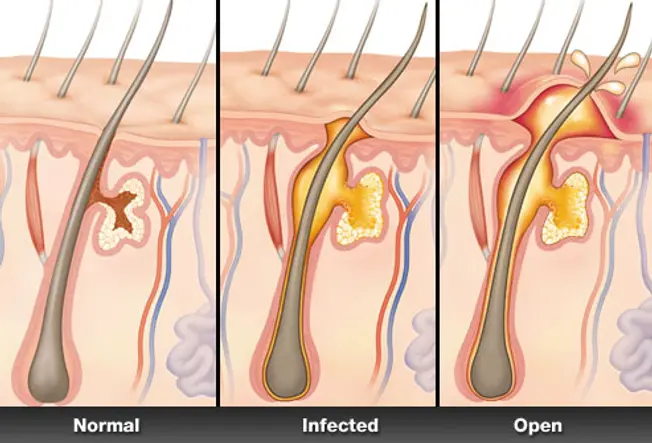
A boil is a common, painful infection of a hair follicle and the surrounding skin. It begins as a red lump, then fills with pus as white blood cells rush in to fight the infection. Good home care can often clear up a single boil, also known as a skin abscess. A doctor’s care is needed when a boil resists treatment or develops in certain vulnerable areas of the body.

Boil Symptoms
2/19
Boils are usually pea-sized, but can grow as large as a golf ball. Symptoms can include:
- Swelling, redness, and pain
- A white or yellow center or tip
- Weeping, oozing, or crusting
You may also have a general feeling of ill health, fatigue, or a fever, which is reason to call a doctor.
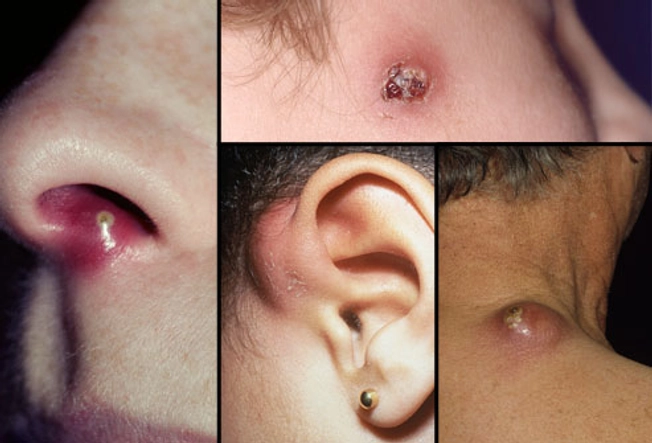
Where Do Boils Form?
3/19
Boils can form anywhere on the body, but they’re most common on the face, neck, armpits, shoulders, back, and buttocks. Hairy, sweaty areas are typical sites, as well as areas of friction, such as the inner thighs. Boils can also develop around the ear or near the nose. The pain often worsens as pus collects under the skin, then eases as fluids begin to drain.
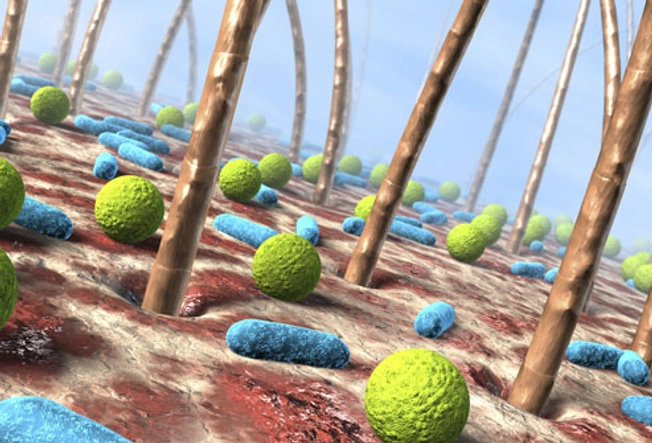
What Causes Boils?
4/19
Most boils are caused by staph bacteria (Staphylococcus aureus), which many healthy people carry on their skin or in their noses without a problem. When a scrape, cut, or splinter breaks the skin, the bacteria can enter a hair follicle and start an infection. Others boils, such as those associated with acne, develop from clogged pores that become infected.
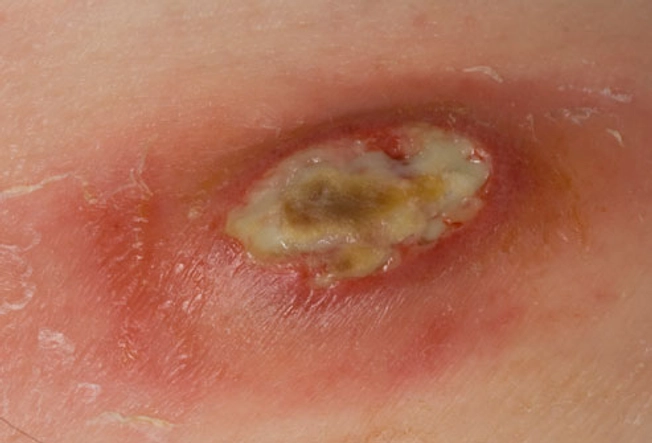
Ordinary Boil or MRSA Infection?
5/19
MRSA can look exactly like an ordinary boil: red, swollen, pus-filled, and tender. But MRSA infections are caused by one particular type of staph that is resistant to many antibiotics. If a skin infection spreads or doesn’t improve after 2-3 days of antibiotics, your doctor may suspect MRSA. The right treatment given promptly is important to heal a MRSA infection and prevent a deeper, more dangerous infection.
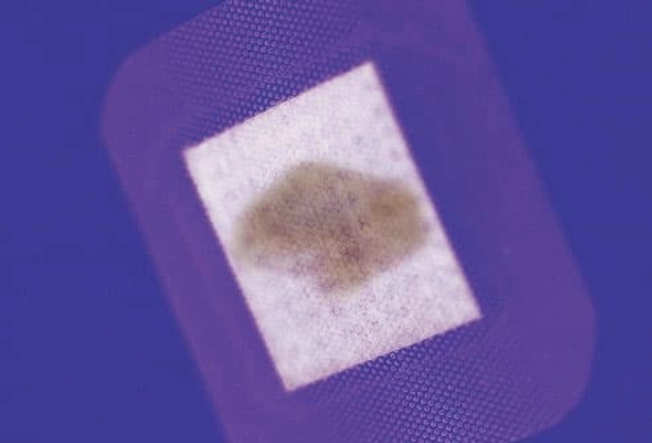
Are Boils Contagious?
6/19
Not exactly, but the germs that cause boils (staph) are easily spread through skin-to-skin contact and contaminated objects. These bacteria usually do no harm unless they find a break in the skin. To avoid spreading staph, don’t share towels, bedding, clothes, or sports gear while you have a boil. Avoid touching the boil, and keep it covered. Frequent hand washing can also help prevent spreading the bacteria.
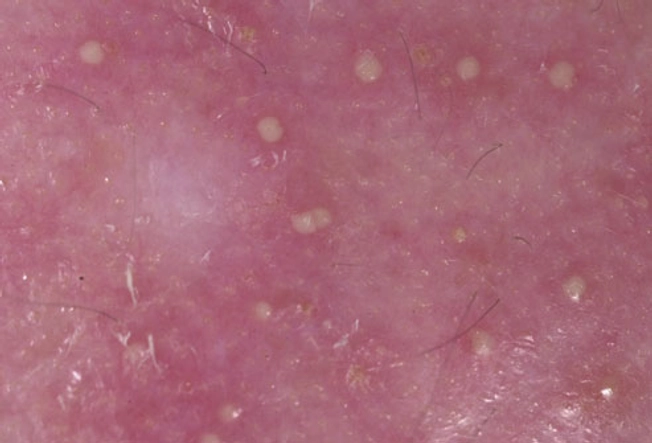
Early Warning: Folliculitis
7/19
Folliculitis is an inflammation or infection of the hair follicles that can develop into a boil. Tiny pimples with whiteheads appear around individual hairs, sometimes surrounded by red skin. It can be itchy, tender, and uncomfortable, but is typically not as painful or deep as a boil. Shaving or friction from tight clothing can let staph bacteria slip under the skin — the most common cause of both folliculitis and boils.
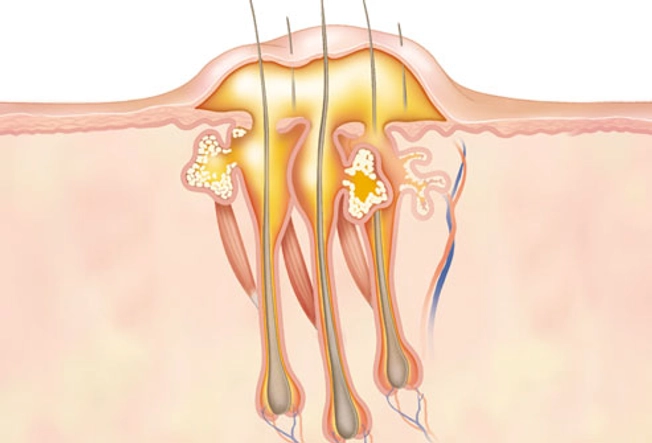
Boil Type: Carbuncle
8/19
When several boils form close together and join beneath the skin, it’s called a carbuncle. They are most commonly found on the back and the neck but can develop anywhere. Men are more likely to develop carbuncles than women. A carbuncle tends to lie deeper beneath the skin than a boil and can take longer to heal.
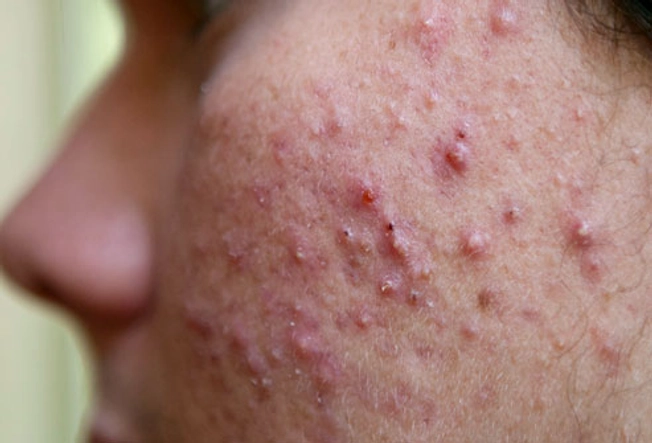
Boil Type: Cystic Acne
9/19
Cystic acne is a type of skin abscess that forms when oil and dead skin cells clog a hair follicle, creating a place where bacteria grow and thrive. It affects deeper skin tissue than regular acne, leading to firm, painful cysts. It’s most commonly on the face and shoulders and typically occurs in the teenage years.
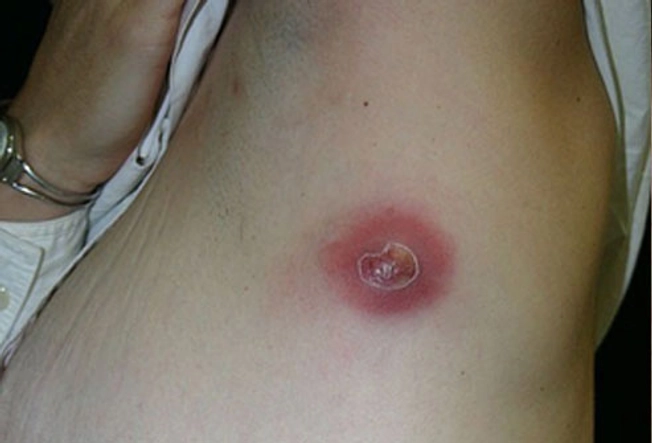
Boil Type: Armpit and Groin
10/19
When lumps and pus-filled abscesses repeatedly develop in these areas of the body, it may be a chronic condition called hidradenitis suppurativa. Infection starts in sweat glands and hair follicles that become blocked. Mild cases heal with home care. Several drugs and treatments are available for more serious and recurring cases.
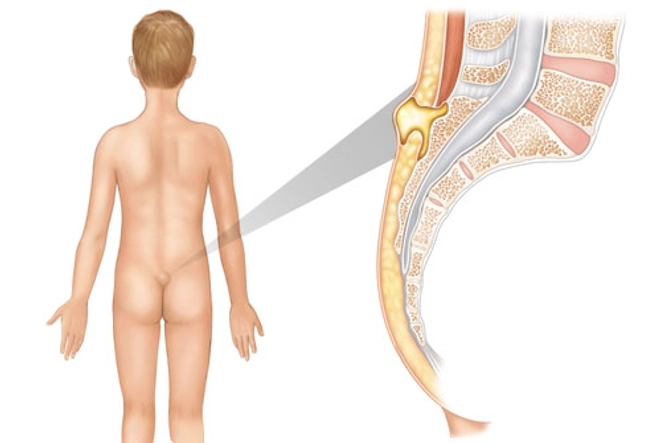
Boil Type: Pilonidal Abscess
11/19
When a boil forms in the skin just above the buttocks crease, it may be a pilonidal abscess. Hair is believed to play a role, and irritation, pressure, and prolonged sitting may also contribute to the development of a cyst here. If a cyst becomes inflamed and infected, it becomes an abscess. Some children are born with a “pilonidal dimple” where infections can crop up. Signs of infection require a doctor’s attention.
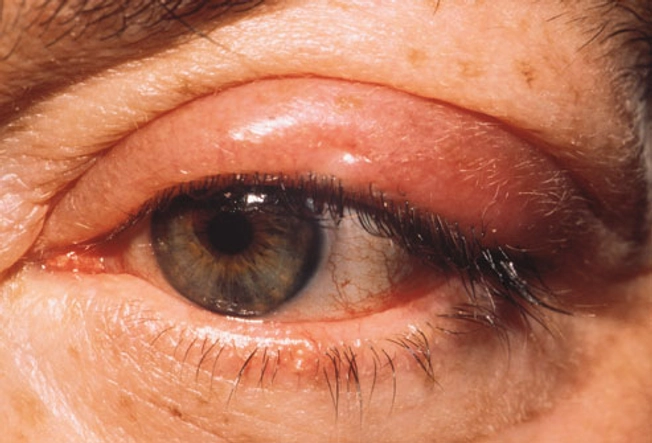
Boil Type: Stye
12/19
The familiar “stye on the eye” is a boil, usually caused by staph bacteria. It starts in the follicle of an eyelash and may be red, warm, swollen, and uncomfortable. A stye is sometimes confused with a chalazion, which is also a lump on the eyelid, but a chalazion is usually painless and is caused by a blocked oil gland, not an infection.
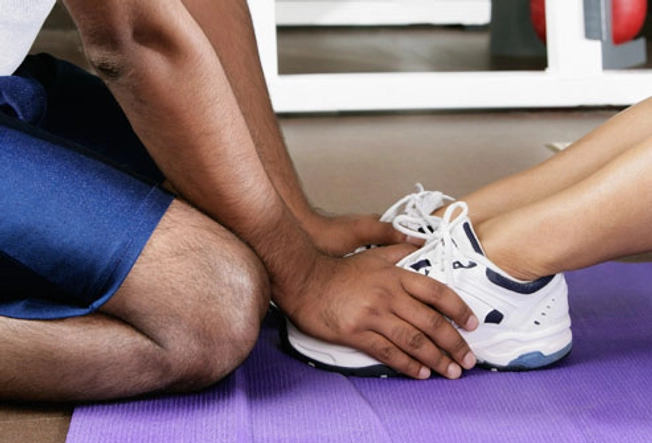
Who Gets Boils?
13/19
Anyone can develop a boil. The risk increases with:
- Close contact with an infected person
- Acne, eczema, or other causes of breaks in the skin
- Diabetes
- A weakened immune system
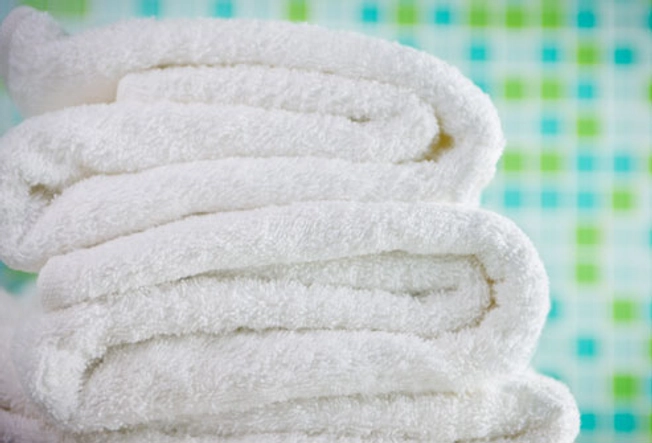
Treatment: Home Care
14/19
You can take care of most boils at home. Apply warm, moist compresses several times a day to help a boil open and drain. After it starts draining, keep it clean, and continue using warm compresses — a clean one every time. Change the bandage often and wash hands well. Resist the urge to squeeze or pop the boil. This can make the infection worse.
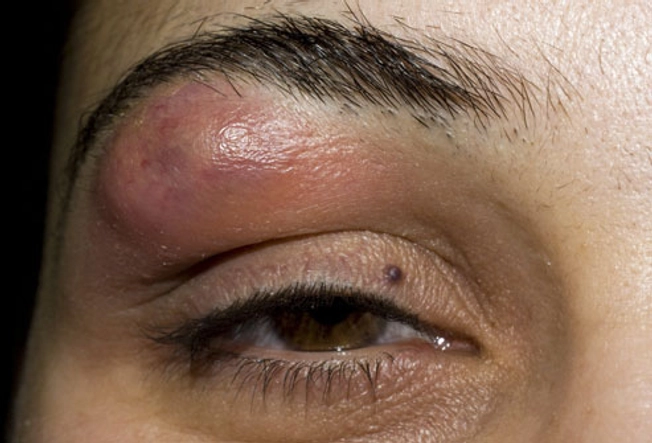
When to Call the Doctor
15/19
If a boil doesn’t heal after a week of home care, call your doctor. Other reasons to call include:
- A boil on the face or spine
- A fever or red streaks coming from the sore
- A very large or painful boil
- A boil that keeps coming back
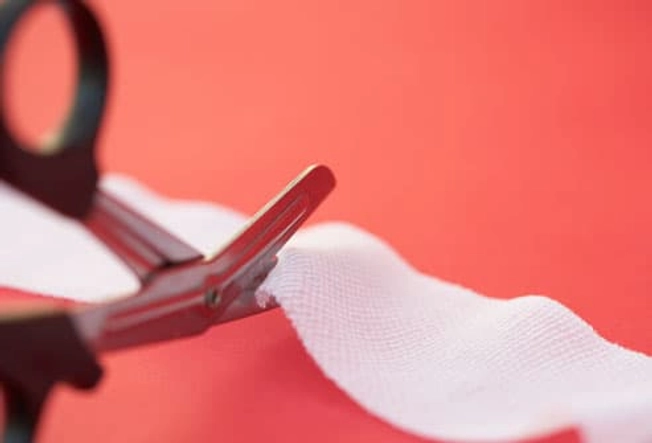
Treatment: Procedures
16/19
If the fluid inside a boil doesn’t drain by itself, your doctor may prick the top of the sore with a sterile instrument to be sure it drains completely. A deep infection may be packed with sterile gauze so it continues to drain. Antibiotics and steroid shots are sometimes given to help with healing.
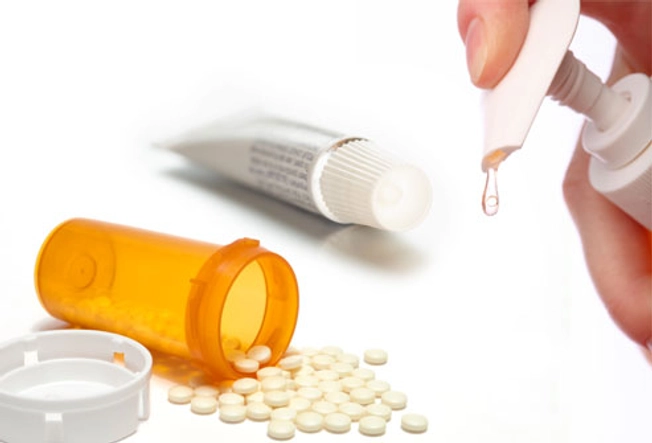
Treatment: Recurrent Boils
17/19
For some people, boils are a recurring problem. In addition to standard treatment, your doctor may try to eliminate or reduce staph bacteria throughout the body. This can include any or all of the following treatments: washing up with a special antiseptic soap, using an antibiotic ointment inside the nose, or, if necessary, 1-2 months of antibiotics taken by mouth.
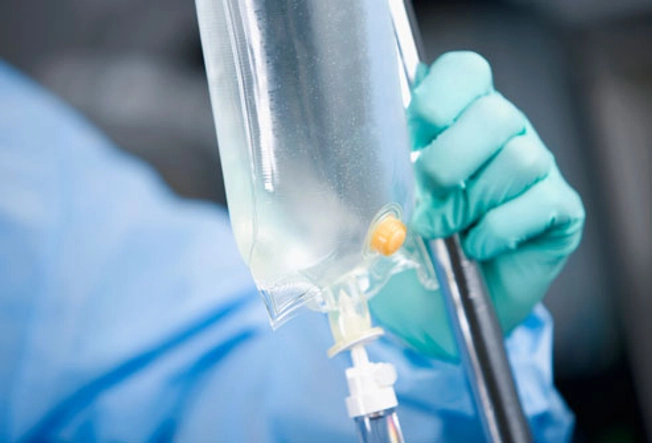
Boil Complications
18/19
Most boils heal with home treatment or a doctor’s visit. Sores on the face may require antibiotics because they’re so close to the eyes and brain. Rarely, the staph bacteria from a boil or carbuncle can get into the bloodstream, which can then affect the heart and other internal organs.
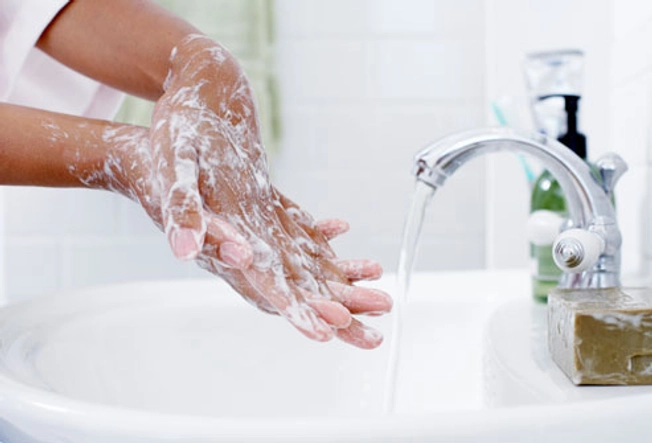
How to Prevent Boils
19/19
Since bacteria are everywhere in our environments and on many people’s skin, the best defense against boils includes:
- Hand washing or use of alcohol-based hand sanitizer
- Careful cleaning of cuts, scrapes, and other wounds
- Keeping wounds covered
- Not sharing towels, sheets, razors, etc.
Wash towels, sheets, and anything else in contact with an infected area in very hot water. Throw away any wound dressings in a tightly sealed bag.
Show Sources
IMAGES PROVIDED BY:
1) Peggy Firth and Susan Gilbert for WebMD
2) Dr. P. Marazzi / Photo Researchers, Inc, Watney Collection / Phototake, ISM / Phototake
3) Watney Collection / Phototake, ISM / Phototake, Biophoto Associates / Photo Researchers, Inc, Interactive Medical Media LLC
4) David Mack / Photo Researchers, Inc
5) Interactive Medical Media LLC
6) Stockbyte
7) Interactive Medical Media LLC
8) Peggy Firth and Susan Gilbert for WebMD
9) Anna Webb/WebMD
10) Interactive Medical Media LLC
11) Peggy Firth and Susan Gilbert for WebMD
12) Phototake
13) Medioimages/Photodisc
14) Fuse
15) Dr. Harout Tanielian / Photo Researchers, Inc.
16) Siri Stafford/Photodisc
17) Stockbyte, iStock
18) Medioimages/Photodisc
19) Sean Justice/Digital Vision
Nemours Foundation: “Staph Infections.”
University of Chicago Medical Center: “MRSA FAQ.”
Merck Manual of Medical Information, 2nd Home Edition: “Folliculitis and Skin Abscesses.”
NIH Genetics Home Reference: “Hidradenitis Suppurativa.”
Hidradenitis Suppurativa Foundation: “What is Hidradenitis Suppurativa?”
American Academy of Ophthalmology: “What Are Chalazia and Styes?”
Boils: Pictures, Causes, Symptoms and Treatment

What is a boil? A boil is a skin abscess that forms deep inside a hair follicle or oil gland. A boil is caused by a bacterial skin infection. A boil generally starts as a reddened, tender area. Over time, the area becomes firm and hard.
The infection damages your skin cells, hollowing the tissue out. Your immune system responds with white blood cells, which fill the center of the infection and make it soft. Your body makes these cells to destroy the infection.
Together with bacteria and proteins, these white blood cells are known as pus. This pus may eventually form a central head near the surface of your skin. This head may drain on its own, spilling out of the surface of your skin. If not, it can be surgically opened.

What Symptoms Are Related to Boils?
A boil starts as a hard, red, painful, pea-sized lump. It is usually less than an inch big. Over the next few days, the lump becomes softer, larger, and more painful. Soon, a pocket of pus forms on the top of the boil.
Here are some symptoms related to a severe boil infection:
- the skin around the boil becomes red, painful, and swollen;
- several boils may cluster around the original one (a carbuncle);
- a fever develops;
- the lymph nodes in the area become swollen

Where Do Boils Appear on Your Body?
The most common places for boils to appear are on your:
- neck,
- armpits,
- shoulders,
- buttocks.
When a boil occurs on your eyelid, it is called a sty (stye).

Why Do Boils Form?
Boils are caused by bacteria, and usually the infectious bacterium is Staphylococcus aureus. Many staph infections develop into abscesses and can become serious very quickly. One big concern is that S. aureus is the same strain that causes MRSA infections (methicillin-resistant S. aureus).
This germ can be present on normal skin and enters the body through tiny breaks in the skin or by traveling down a hair to the follicle. Some boils can be caused by an ingrown hair. Others can form as the result of a splinter or other foreign material that has become lodged in the skin that causes the infection to develop.

Additional Causes of Boils
Your skin is an essential part of your immune defense against materials and microbes that are foreign to your body. Any break in your skin, such as a cut or scrape, can develop into an abscess (boil). Consequently, not all boils originate in hair follicles.

Boils Usually Start as Inflamed Hair Follicles
Folliculitis is an inflammation or infection of the hair follicles. This condition can develop into a boil and appears as numerous small red or pink little bumps at the hair follicles.
Infection of the hair follicles can occur when the skin is disrupted or inflamed due to a number of conditions, including acne, skin wounds or injuries, friction from clothing, excessive sweating, or exposure to toxins.

Can Boils Become Contagious?
Boils themselves are not contagious, but S. aureus is. Until it drains and heals, an active skin boil can spread staph infection. The infection can spread to other parts of the person’s body or to other people through skin-to-skin contact or the sharing of personal items, such as towels or washcloths.

What Are the Types of Boils?
There are several different types of boils. Another name for a boil is “furuncle.” Among these are
- carbuncle
- hidradenitis suppurativa (seen in the armpit or groin)
- pilonidal cyst (area on the back where the buttocks merge)
- cystic acne
- sty (stye)

Carbuncle vs Furuncle
A carbuncle is an abscess in the skin caused by the bacterium Staphylococcus aureus. It usually involves a group of hair follicles and is therefore larger than a typical furuncle, or boil. A carbuncle can have one or more openings onto the skin and may be associated with fever or chills.
Carbuncles are considered more serious skin conditions. When you have multiple carbuncles, the condition is known as carbunculosis. This skin condition may not respond to home remedies, and is more likely to need expert treatment from a health care professional.

Cystic Acne
Cystic acne is a type of abscess that is formed when oil ducts become clogged and inflamed. Cystic acne affects deeper skin tissue than the more superficial inflammation from common acne. Cystic acne is most common on the face and typically occurs in the teenage years.

Hidradenitis Suppurativa
Hidradenitis suppurativa is a condition in which there are multiple abscesses that form under the armpits and often in the groin area. These areas are a result of local inflammation of the hair follicles. This form of skin inflammation is difficult to treat with antibiotics alone and typically requires a surgical procedure to remove the involved hair follicles in order to stop the skin inflammation.

Pilonidal Cyst
A pilonidal cyst is a unique kind of abscess that occurs in or above the crease of the buttocks. Pilonidal cysts often begin as tiny areas of inflammation in the base of the area of skin from which hair grows (the hair follicle). With irritation from direct pressure, over time, the inflamed area enlarges to become a firm, painful, tender nodule making it difficult to sit without discomfort. These cysts frequently form after long trips that involve prolonged sitting.

Eyelid Sty
A sty (also spelled stye) is a tender, painful red bump located at the base of an eyelash or under or inside the eyelid. A sty results from a localized inflammation of the glands or a hair follicle of the eyelid. A sty is sometimes confused with a chalazion, a lump on the inner portion of the upper or lower eyelid, but a chalazion is usually painless and caused by obstruction and inflammation of an oil gland, not an infection.

Who Is Most Likely to Develop a Boil?
Anyone can develop a boil. However, people with certain illnesses or medications that impair the body’s immune system are more likely to develop boils. Among the illnesses that can be associated with impaired immune systems are diabetes and kidney failure. Diseases, such as hypogammaglobulinemia, that are associated with deficiencies in the normal immune system, can increase the tendency to develop boils. Many medications can suppress the normal immune system and increase the risk of developing boils. These medications include cortisone medications (prednisone and prednisolone) and medications used for cancer chemotherapy.

What Is the Treatment for a Boil?
Most simple boils can be treated at home. Ideally, the treatment should begin as soon as a boil is noticed since early treatment may prevent later complications. The primary treatment for most boils is heat application, usually with hot soaks or hot packs. Heat application increases the circulation to the area and allows the body to better fight off the infection by bringing antibodies and white blood cells to the site of infection. Do not pop the boil with a needle. This usually results in making the infection worse.

Should Boils Be Drained?
As long as the boil is small and firm, opening the area and draining the boil is not helpful, even if the area is painful. However, once the boil becomes soft or “forms a head” (that is, a small pustule is noted in the boil), it can be ready to drain. Once drained, pain relief can be dramatic. Most small boils, such as those that form around hairs, drain on their own with soaking and/or heat application. On occasion, and especially with larger boils, the larger boil will need to be drained or “lanced” by a health-care practitioner. Frequently, these larger boils contain several pockets of pus that must be opened and drained.

Why Do Boils Keep Coming Back? Recurring Boils
Once boils appear once, they may return. About 10% of people who develop a boil will develop another one within a year. Some people suffer from recurring boils (“recurrent furunculosis”). Home remedies and over-the-counter medicines may not be enough for this skin problem. Prescription antibiotics may be used to eliminate the responsible staph bacteria.
Especially if the skin surrounding your boil is infected, your doctor will often prescribe antibiotics. However, antibiotics are not always helpful.
Antibiotics have difficulty penetrating the outer wall of a boil. They often will not cure a boil without additional surgical drainage. In most cases, incising and draining the boil is sufficient to cure the infection. Your doctor should discuss the use or non-use of antibiotics for your condition.

When Should You Seek Medical Attention?
You should call your doctor and seek medical attention if:
- the boil is located on your face, near your spine, or near your anus;
- a boil is getting larger;
- the pain is severe;
- you have a fever;
- the skin around the boil turns red or red streaks appear;
- you have a heart murmur, diabetes, any problem with your immune system, or use immune-suppressing drugs (for example, corticosteroids or chemotherapy) and you develop a boil;
- the boil has not improved after five to seven days of home treatment;
- you get many boils over several months.

What Can Be Done to Prevent Boils (Abscesses)?
Good hygiene and the regular use of antibacterial soaps can help to prevent bacteria from building up on the skin. This can reduce the chance for hair follicles to become infected and prevent the formation of boils. Your health-care practitioner may recommend special cleansers such as Hibiclens to further reduce the bacteria on the skin.

Is Surgery Needed for More Serious Boils?
Pilonidal cysts can be prevented by avoiding continuous direct pressure or irritation of the buttock area when a local hair follicle becomes inflamed. Regular soap and hot water cleaning and drying can be helpful. For acne and hidradenitis suppurativa, antibiotics are used and anti-inflammatory agents like corticosteroids may be required on a long-term basis to prevent recurrent abscess formation.
Finally, surgery may occasionally be needed, especially for hidradenitis suppurativa or pilonidal cysts that recur. For pilonidal cysts, surgically removing the outer shell of the cyst is important to clear the boil. For hidradenitis suppurativa, extensive involvement can require plastic surgery.
IMAGES PROVIDED BY:
- Peggy Firth and Susan Gilbert for WebMD
- iStockPhoto
- BigStock
iStockPhoto
Deposit Photo
BigStock
iStockPhoto - MedicineNet
Image courtesy of Zen Sutherland
iStockPhoto - iStockPhoto
iStockPhoto - iStockPhoto
- BigStock
- MedicineNet
- El Pantera – Own work, CC BY-SA 3.0, https://commons.wikimedia.org/w/index.php?curid=15546100
Medicalpal - John F. Wilson, MD.
- Image reprinted courtesy of eMedicine, 2008
- MedicineNet
- Image courtesy of Andre Riemann – Wikimedia Commons
- BigStock
- 123RF
BigStock - Image courtesy of Mahdouch – Wikipedia
CDC - iStockPhoto
- BigStock
- iStockPhoto
- iStockPhoto
- British Journal of General Practice: “Incidence and recurrence of boils and abscesses within the first year: A cohort study in UK primary care.”
- Clinical, Cosmetic and Investigational Dermatology: “Recurrent furunculosis—Challenges and management: A review.”
- Institute for Quality and Efficiency in Health Care: “Boils and carbuncles: Overview.”
What’s the Difference Between a Pimple and a Boil?
Leah Ansell, MD, is a board-certified dermatologist and an assistant professor of dermatology at Columbia University.
A large whitehead on your skin may not be an acne pimple. You may have a boil.
Large acne pimples and boils can look very similar. They are both swollen, painful lumps with white heads. They are both filled with thick, yellowish fluid.
Acne pimples and boils are not the same, though. They have different causes and treatments. This means you need to know which one you have before you can treat it.
This article describes some of the differences between pimples and boils, and how they should be treated.
:max_bytes(150000):strip_icc()/difference-between-a-pimple-and-a-boil-15613-5c869a5446e0fb0001a0beb6.png)
Underlying Causes
:max_bytes(150000):strip_icc()/boil2-b9c865eae637412c96b4e2b59fdf71c9.jpg)
Boils and pimples have different causes.
What Is a Boil?
Boils are also called furuncles or abscesses. They are infected hair follicles.
Staphylococcus aureus bacteria are the most common cause of boils. Other bacteria and fungus can also cause boils, though.
A boil looks like a large acne pimple. It starts as a painful, firm, red lump under the skin. Over the course of several days, it grows larger, softens, and develops a white, pus-filled head.
At first it can be hard to tell the difference between a boil and a pimple. A pimple can also start out as a firm, red, painful lump.
What Is a Pimple?
A pimple is not caused by an infection. It’s caused by a blocked pore. The pore becomes blocked by a plug of oil and dead skin cells.
The oil and dead skin cells irritate the pore, causing redness and swelling. The acne-causing bacteria Propionibacterium acnes also play a role.
Click Play to Learn How to Handle Large Pimples
This video has been medically reviewed by Casey Gallagher, MD.
Location
Location is a clue as to whether a blemish is a pimple or a boil.
Locations for Pimples
If the large blemish is on your face, it’s probably an acne pimple. Pimples are common on the face, upper back, shoulders, and chest area.
Severe or cystic acne can cause very large, tender, inflamed blemishes. These cyst-like blemishes are in deeper structures of the skin than typical pimples. They can look similar to boils.
You may sometimes get large, lone pimples even if you don’t have regular breakouts. These usually go away within a week or so.
Locations for Boils
A large lump that appears in these places is probably a boil:
You don’t usually get acne in these places. This means if you have a bump there it’s unlikely to be a pimple. Boils, though, are very common in these areas.
Still, boils are also common in the face and neck area, just like acne. So location alone isn’t always enough to determine if it’s a boil or pimple.
Recap
You don’t usually get acne in the groin or thigh area, breast, armpit, or foot. If you have a blemish in one of these places, it’s likely to be a boil.
Size
The size of the blemish is also a clue. If it’s dime-sized or smaller, it is more likely to be a pimple. If it’s larger than a nickel, it’s probably a boil.
Size of Boils
One of the key differences between boils and pimples is size. The size of boils vary. They can be the size of a cherry and up to the size of a walnut, sometimes even larger. A blemish that size is most likely a boil.
Size of Pimples
Some pimples can grow very large. Even the largest pimple, though, won’t get much larger than a dime.
Most of the “giant pimple-popping” videos on YouTube are not pimples but boils. Note that boils should never be popped at home.
How To Treat a Big Pimple
An untreated pimple should heal within seven to 14 days. The lump underneath the skin can take longer to go away.
Sometimes these lumps can last a few months. This depends on how deep and inflamed the pimple was.
Ice can help relieve some of the swelling and pain. Wrap an ice cube in a soft cloth and hold it over the pimple for a couple of minutes. Do this two to three times a day. Icing won’t help the pimple heal faster, but it can help it feel better.
An over-the-counter (OTC) spot treatment containing benzoyl peroxide or Differin (adapalene) can also help.
Both these products can relieve inflammation and help the blemish heal more quickly. Note, though, that topical medications don’t work as well on very deep blemishes.
A regular acne treatment can help prevent acne. The goal is to stop large pimples from forming.
How to Treat a Boil
Boils can often be treated at home. They typically take several days, sometimes more, to come to a head and drain. Once they drain, the healing process can start.
You can help your boil to come to a head. Cover it with a warm, damp compress several times a day.
Make sure you wash your hands well before and after touching your boil. Don’t ever try to lance or pop it.
Call a doctor if:
- If you aren’t getting results with home care
- Your boil is getting worse
- Your boil is very painful
- You’re feeling unwell
You should also call a doctor if your boil is on your face or you have multiple or recurring boils.
Your doctor can lance and drain your boil. Prescribed medication can help clear the infection.
Recap
Pimples can be treated with ice and a topical ointment like benzyol peroxide. Covering a boil with a warm, damp compress can help it come to a head and drain. Never try to lance or pop a boil at home.
Summary
Boils and large pimples look very similar. They have different causes and treatments, though. Boils are infected hair follicles. Pimples are blocked pores.
You may be able to tell the difference based on location. Pimples usually appear on the face, back, shoulders, and chest. Blemishes that appear elsewhere may be boils.
Pimples are rarely larger than a dime. Boils may be much larger than that.
You can treat a pimple with ice and a spot treatment like benzoyl peroxide. A boil can be treated with a warm, damp compress to help it come to a head and drain.
See a doctor if your boil doesn’t get any better or you are in pain or feel unwell.
A Word From Verywell
They can look very similar, but boils and pimples are completely different skin problems. They’re treated differently too. That’s why it’s important to know what you have before starting home care.
If you still aren’t sure what’s causing your inflamed whitehead, call your doctor. A simple exam will lead to the right diagnosis and treatment.
Frequently Asked Questions
How do you treat a big pimple under the skin?
A big pimple under the skin may be nodular acne. You can relieve pain by applying a wrapped ice pack to the acne. However, proper treatment often requires a prescription from a healthcare provider since over-the-counter drugs are usually not strong enough, Nodular acne is a type of acne that creates large pimples which develop in deeper layers of skin.
Can you get a boil on your ear?
Yes, you can get a boil on your ear. Any area of the body can have them, although boils often appear on the face, neck, groin, thigh, foot, armpit, or breast. To treat the boil, start by pressing a warm, damp compress against it multiple times every day. If the boil doesn’t see improvement after several days or gets worse, you may need to contact your healthcare provider so they can drain the boil.
What is the difference between a zit and a pimple?
There is no difference between a zit and a pimple. They are both used as words to describe acne, which everyone will experience at least once in their lifetime. Topical treatments in the form of a cream or gel can be effective in treating persistent acne, but if over-the-counter solutions aren’t effective, a prescription medication can help.
Verywell Health uses only high-quality sources, including peer-reviewed studies, to support the facts within our articles. Read our editorial process to learn more about how we fact-check and keep our content accurate, reliable, and trustworthy.
- Taylor T, Chandrashekhar G. StatPearls. Staphylococcus aureus.
- MedlinePlus. Acne.
- Tanghetti E. The role of inflammation in the pathology of acne.J Clin Aesthet Dermatol. 2013;6(9):27–35.
- Rubenstein RM, Malerich SA. Malassezia (pityrosporum) folliculitis. J Clin Aesthet Dermatol. 2014;7(3):37-41.
- Guillet A, Brocard A, Bach Ngohou K, et al. Verneuil’s disease, innate immunity and vitamin D: a pilot study. J Eur Acad Dermatol Venereol. 2015;29(7):1347-53. doi:10.1111/jdv.12857
- US National Library of Medicine. Boils and Carbuncles: Overview.
- Rathi SK. Acne vulgaris treatment: the current scenario.Indian J Dermatol. 2011;56(1):7-13. doi:10.4103/0019-5154.77543
- Scuderi N, Monfrecola A, Dessy LA, Fabbrocini G, Megna M, Monfrecola G. Medical and surgical treatment of Hidradenitis suppurativa: a review.Skin Appendage Disord. 2017;3(2):95-110. doi:10.1159/000462979
- National Health Service (NHS). Boils.
Additional Reading
- US National Library of Medicine. Boils.
- Zaenglein AL, Pathy AL, Schlosser BJ, et al. Guidelines of care for the management of acne vulgaris. J Am Acad Dermatol. 2016;74(5):945-73. doi:10.1016/j.jaad.2015.12.037
By Angela Palmer
Angela Palmer is a licensed esthetician specializing in acne treatment.






